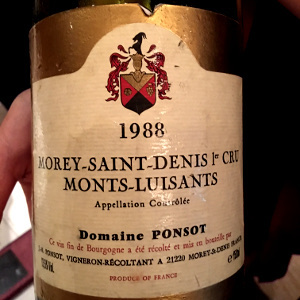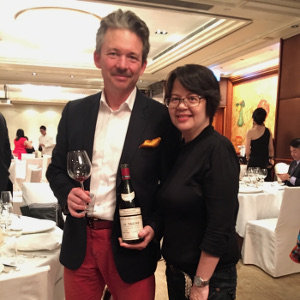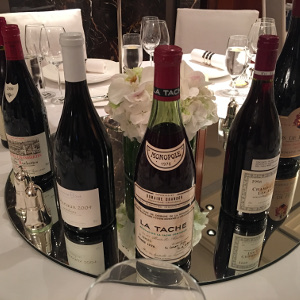May Saint Vincent Bless You



Fortunately it is not necessary to march in the saint’s parade during a cold Burgundian winter in order to commemorate the memory of Saint Vincent of Saragossa. I was happy to pass my Saint Vincent this year in the very civilized environs of the Mandarin Oriental Hong Kong at a dinner organized by the local importer Pearl of Burgundy. It was a few days in advance of his official celebration on 22 January – peu importe! A number of winemakers were present and pouring their wine, and the guests had all brought wine from their cellar. We tasted some marvels.
Although Saint Vincent is the patron saint of vintners, his association with the grape is a bit of a mystery. We do know that he was the first martyr of Spain, who died in Valencia in 304 AD under the rein of Emperor Diocletian. French winemakers, who like him perhaps because his name starts with “Vin”, have long celebrated his feast day. In 1938 the Confrérie des Chevaliers du Tastevin resurrected the official celebration of the saint, which takes place in a different village each year, and is thus known in Burgundy as the “Saint Vincent Tournante”, which is celebrated on the last weekend in January.
The first wine of the evening was a 2014 Meursault Genevrières (***) provided by our vintner host, Domaine Tessier, which showed a clean fresh note of lemon peel and butter. It was fresh and elegant on the palate, with lovely balance and a lingering finish. Friends from Zachys Wine Auctions brought a magnum of 1988 Morey Saint-Denis Clos des Monts Luisants from Ponsot (*****) that was extraordinary, with notes of caramel and honey on the nose that open up to truffle and mineral. This is a very particular wine, produced in large part from Aligoté planted in 1911. In the 1930s, Laurent Ponsot’s grandfather Hippolyte planted about 15% of the vineyard to a variety called “Pinot Gouges”, which was a Pinot Noir vine from Domaine Henri Gouges that had mutated to produce white grapes which Gouges had propagated via cuttings. In the 1950s, Laurent’s father Jean-Marie planted about 20% of the vineyard to Chardonnay, and this was the approximate grape blend of our 1988 magnum. In 1992 the Pinot Gouges was ripped up, and in 2004 the Chardonnay was as well, and from 2005 this wine is produced from 100% Aligoté, making it the only premier cru in Burgundy produced exclusively from this grape.
Next was a 1990 Chevalier Montrachet from Leflaive (*****) that was mature and rich, also showing a deeply honeyed cast to the lovely ripe fruit. The level of oxidation was perfectly commensurate with its 27 years, however, and there was still sufficient freshness to keep the wine lively. A 2000 Les Clos from Raveneau (****/*) brought all the way from Chicago by a wine-loving friend was still youthful but showing well, with a tender, silky texture, bright acidity and a powerful finish. A 2008 Puligny Montrachet Les Enseignières from Coche Dury (****) was crisp and fresh with a nervy, almost frenetic texture to balance the rich fruit and cask aromas of the youthful wine – it will definitely benefit from a bit more age, as will the 2012 Corton Charlemagne from Roumier (****), which showed immense potential, but was much too young to drink. The focus here was firmly on the mineral side, with aromas that were almost petrol in nature and a crisp, racy texture that will take a few years to calm down.
I couldn’t resist opening the wine that I brought from New York as the first of the reds. It was a bottle of 1976 La Tâche (*****) that had a 5cm ullage but a bright cherry red color. It had been bought on release and professionally stored and it was still in superb shape, with a fantastic nose of ripe plummy fruit that testified to the warmth of the vintage, edged in aromas of truffle and earth. The texture was rich and soft. Although mature, it is still holding extremely well.
There was also a pair of Drouhins from 1976 that evening, The Musigny (****/*) showed a lacy elegance and a lovely perfume of fresh and dried flowers that balanced perfectly richness and finesse, while a Griotte Chambertin (***) almost seemed more youthful but a shade less complex.
Next was a pair of wines from 1980 that couldn’t have been more different. A Clos Saint Jacques from Pernot-Fourrier (****) was elegant, silky and fresh, with aromas of raspberry, currant and violets and a subtle sense of earth, while the Leroy Musigny (*****) was a powerhouse of a wine, with incredible density and depth of flavor, showing ripe plum and fig, chocolate and mocha aromas and a hint of smoke.
Before we got to the really young wines, we had two strong efforts from “off” vintages. The 1987 Richebourg Jean Gros (**/*) was holding well, if somewhat soft. The fruit was mature but not overly so, and the structure was silky and fine if lacking a bit of power. A 2004 Echézeaux from Bizot (****) showed that one should never dismiss a vintage completely, as this punched well above its weight class. The wine was elegant and fresh, yet there was a core of very solid cherry fruit and some rewarding earthy nuance. Well done.
The first serious case of infanticide was the 2003 Ponsot Clos de la Roche (***/*). It was a monstrously huge wine, if a bit undrinkable. Concentrated and dense, it showed a muscular black fruit character and still showed an almost frightening tannic grip. Tremendous potential, but will it ever come around? We would also have to qualify a 2009 Ruchottes Chambertin Clos des Ruchottes from Rousseau (****) as infanticide, but the ’09 vintage is much more approachable than the ’03 in general, and this wine was tremendously drinkable, with an exuberant nose of fresh flowers and a forward, grapey sex appeal to the fruit touched with a bit of spice that made it irresistible. From my notes: “I could drink this all night”, and I probably did.
All in all, a superb night, worth the trip to Hong Kong. I think we did Saint Vincent proud.
Comments